By Robin Hsu 沁兒
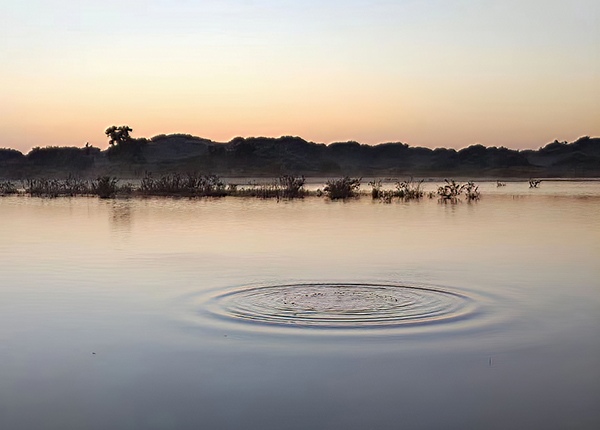
Legend has it:
The 6th Dalai Lama, Tsangyang Gyatso, while
Escorted to Beijing through Qinghai,
Cleverly Escaped and Ever Since Lived An Ordinary, Anonymous Life.
I caught a few friends in August this year to take the Great Northwest Loop Trip which reportedly includes Jiayuguan and Mogao Grottoes.
The overview of the whole trip was that Jiayuguan was cut off on the third day of the itinerary, after optimization. While at Mogao Grottoes, a friend of mine and I felt that there was not enough time. Plus we encountered a broken car at an altitude of about 3,800m, and the day before the departure of the trip, I was surprised to find that my friends had increased from three to ten in our group.
Since this itinerary was full of interesting people and experiences, I decided to write down my travel notes and end this article with a comma!
That’s right! It’s just a comma. Because, one day, I will return to the Northwest, to Dunhuang, amid the sound of camel bells, and once again walk in the glory of a thousand years ago, mesmerized by the brilliance of that era.
The original itinerary was for a sleeper bus trip from Beijing to Xining, and then another sleeper bus drive from Xining to the Northwest.
Imagination is beautiful, but the reality is very cruel.
I think it must be that we started our trip incorrectly. While the bus was dispatched, several people were still working overtime, including me. Then I met the tour guide who also went to Ulan Buddhism with me last time. Maybe when we united again, some kind of aura was too strong, so the car happily broke down, and the cause seemed to be a faulty cylinder or the like.
There is a legend among the Indians that people need to stop and wait for their souls to catch up. Maybe it is believed that most young people nowadays are walking too fast and their hearts do not keep up. Therefore, during the car problem, we pressed the temporal pause button and waited for everyone’s soul to catch up. After everyone’s souls caught up, then the real spiritual journey could start. In the time we waited, we had the best fateful encounter during the rest of the trip.

On the first day of the trip, we hurried our way, with just the thought that China is too big. I mean, everyone knows that China is very big, but you can only appreciate how big it is when you are traveling.
Traveling to Xinjiang by bus for seven days, an average of more than seven hours a day, almost one scenic spot a day, the trip only covered a small part of Xinjiang. Xinjiang, if I remember correctly, is the only province where all cities in the province have airports.
For the Daocheng Yading Line in Sichuan, it is the same. It takes about seven days by bus, an average of more than seven hours a day, and it is uninterrupted travel from Chengdu along part of the 318 National Highway through Shangri-La to Lijiang, Yunnan. The road is full of mountains, unlike the north. It takes luck to find a place to go roaming around.
In Inner Mongolia, we traveled for three days and drove more than five hours a day. Starting from Beijing, you get a taste of Hohhot, Daqi, Baotou, and Ulanbutong. In the strictest sense, Hohhot is only an overnight stopover.
China is so big that one cannot appreciate it without direct, personal experience.
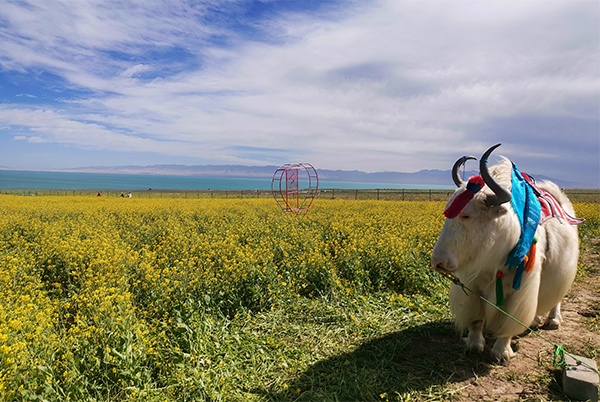
After a long drive, we finally arrived at the first stop on our itinerary: Qinghai Lake.
In recent years, Qinghai Lake has been in the media and has become a favorite place for many people to wear red clothes and red silk scarves to clock in.
In addition to its beautiful scenery and generally good weather, Qinghai Lake also has its presence in cultural symbols. Besides being related to Tsangyang Gyatso, according to legend Qinghai Lake was transformed from the sun-and-moon mirror that belonged to Princess Wencheng of the Tang Dynasty because she missed her hometown too much.
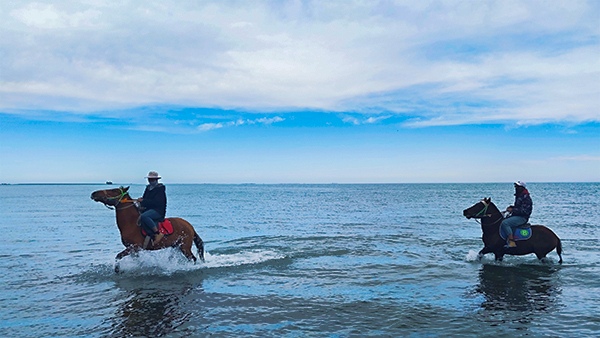
When we arrived at Qinghai Lake, it was cloudy, windy, and cold. But when we were about to get in the car and leave, the sky cleared up. The sun’s rays illuminated a rapeseed field, which was very beautiful. And the normally dim Qinghai Lake also showed its true face under the sunshine. The water of Qingqing Lake has been present for tens of thousands of years, and the waves on the beach and the sound of the wind composed pleasing musical rhythms.
Starting from Qinghai Lake, it seemed that our subsequent journeys were basically cloudy at first, then the sky would clear itself when we started to leave.
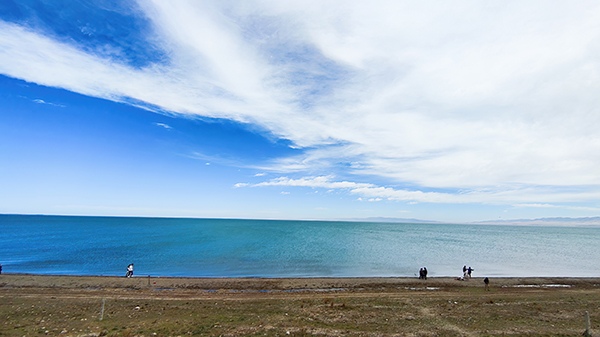
However, at this time, our original sleeper bus decided to express its first protest and go on strike. So, at the next stop, we went directly to the garage to repair the car.
Believe me, the tour guides are definitely the ones who don’t want any unexpected emergencies, more than the tourists.
After repairing the car for nearly two hours and a short while on the road, the car again lived up to our expectations and broke down again!
The bus was completely unable to move. But the worst part was that there was no signal in the area, and an emergency call could not be made.
The main tour guide jumped out of the bus immediately and stopped passing cars along the road looking for someone to help.
The remaining tour guides were responsible for calming everyone down and keeping everyone from getting out of the bus and running around.
At this time, it may have been the altitude, it may have been that the oxygen in the car was thin, or it may have been nervousness. But for whatever reason, many people began to have altitude sickness to varying degrees.
However, I waited for the rescue to arrive then realized that my altitude sickness was cured by this sudden accident. Not only healed, but I could also run and roar at a high altitude.
Although there was still a slight reaction the next day, the overall situation was not as serious as last time in Sichuan. So, yes, maybe I don’t have to wait until I am 80, and now Lhasa can be put back into the future itinerary plan.
The sky was getting darker and darker. At last, the assistant car and the tour guide, Shao Yu, with the oxygen tank, arrived.
Everyone was a little tired but still helped each other and we all squeezed into the minibus together.
The biggest vision that this trip brought me was the hope that the rest of the trip would be without incident. In case something happened, I really hoped that someone could help us.
Fortunately, apart from the inevitable traffic jams, the rest of the trip did not encounter any accidents.
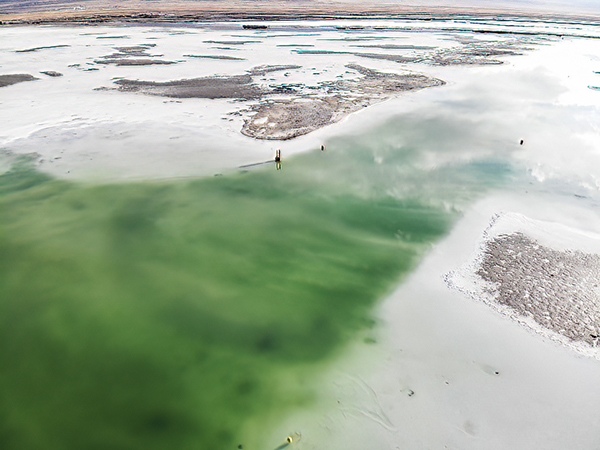
In this way, we spent a day in the midst of surprises but no real dangers.
During the next day and early morning, I had a perfect encounter with Chaka Salt Lake.
How should I describe Chaka Salt Lake upon first sight?
When I first saw it, it was not particularly amazing to me.
The surprise was revealed as we took the small tour train and the beautiful scenes became more and more visible.
It was like the world described by Hayao Miyazaki, but also a postcard-like landscape. People cannot help but go farther and farther into the salt lake just for one’s monologue.
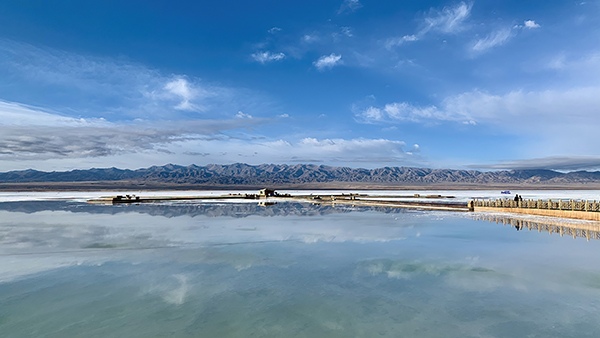
The word “Chaka” is Tibetan, which means salt lake. In addition to beautiful scenery, consuming the green salt produced in Chaka Salt Lake has the effect of reducing heat, detoxifying, and reducing swelling as explained on the small tour train. According to people who have tasted it, green salt has a lighter taste than sea salt. Chaka Salt Lake also sells a nice-tasting blue ice cream made of salt.
As far as my official tour guide card is concerned, this place was the most friendly scenic spot so far. The little brother at the exit of the scenic spot saw me and said, “Tashidler, the tour guide has worked hard”; I felt so happy.
With the blessings of our little Tibetan brother, we embarked on the drive to Dunhuang.
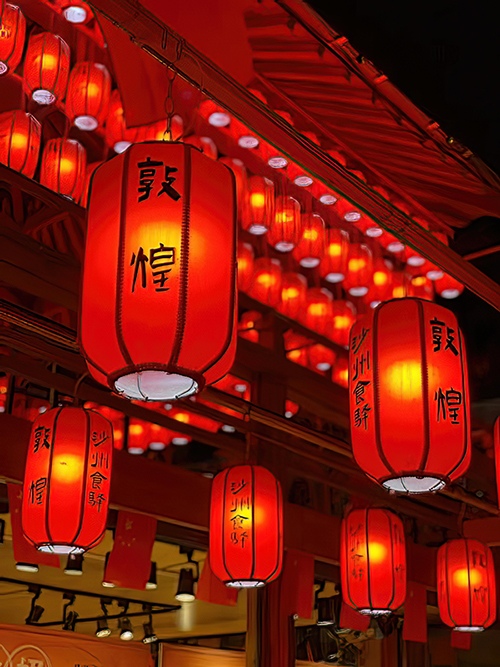
In my imagination, Dunhuang is a city with layers of mystery like a filter of historical yellow sand, full of spices, and silky rustling sights and sounds. Arabs in turbans could be seen everywhere hawking camels, Uyghur girls dancing with hand drums, and Tibetan children with plateau redness on their cheeks running all over the street.
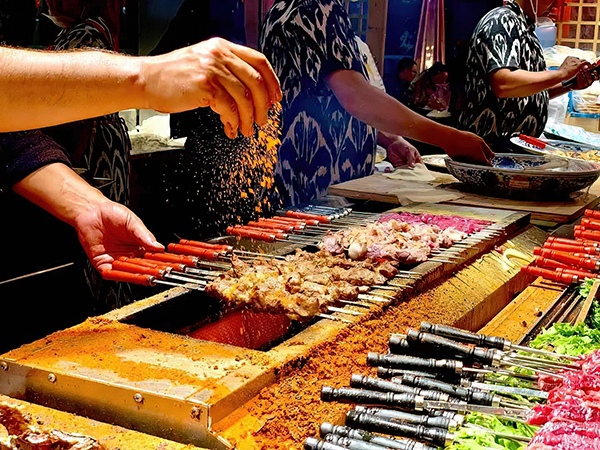
Perhaps the ancient Dunhuang was like this, but the present Dunhuang is very different; it’s modern. Since I only went to the Night Market in Dunhuang, I cannot comment on modern Dunhuang. When I return to Dunhuang next time, I will get to know the modern city better.

Unlike other group members who ate grilled fish and lamb in the night market, the six of us went our separate way to explore the night market. My treasured roommate and I were chatting all the way like two little squirrels running and jumping around in front of the rest of the group. Auntie looked for all kinds of naan bread. Uncle kept an eye on the return time and took various photos. Tina was in charge of the team and this was how we finished the Dunhuang Night Market.
Maybe because of the Chaka Salt Lake visit in the morning, everyone was tired. After the Dunhuang Night Market, we all got on the bus and went back to the hotel to sleep on time.
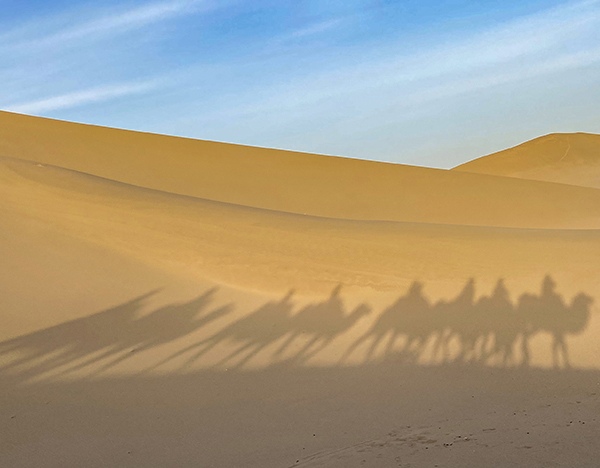
Mingsha Mountain, as the name suggests, is a sandhill where the sand rings with sounds. Since human activity is so loud nowadays, the sands of Mingsha Mountain have long been hard to hear.
But every time I mention the words Mingsha or Xiangsha, I imagine the time when the moon was bright and the wind was high and the sky was dark, and while I closed my eyes the bandits were coming.
The ancient camel teams that passed through the Mingsha area must have paid extra attention as it must not have been easy to hear the sounds of bandits coming.
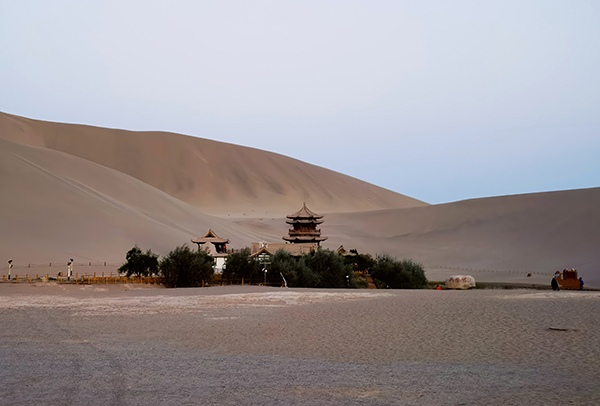
Crescent Spring has existed for thousands of years, and it has been one of the eight greatest scenic spots of Dunhuang since the Han Dynasty.
In the desert, Crescent Spring represents vitality and hope. If you want to watch the sunrise in Crescent Spring, you must choose the right hill, otherwise, you will find there is another hill right in front of you when you go up.
After coming out of Mingsha Mountain, we went to the most important destination for me — Mogao Grottoes.
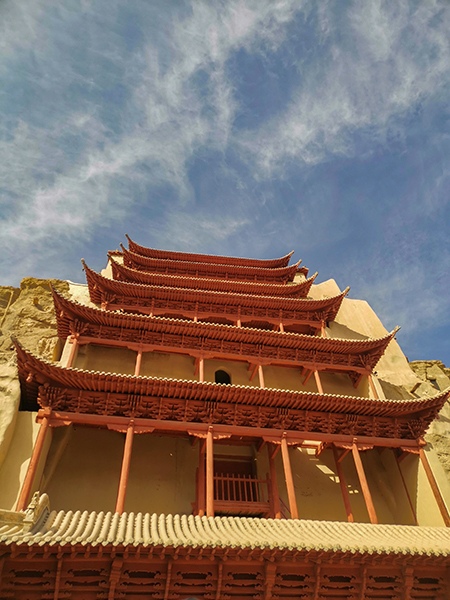
Mogao Grottoes are full of vicissitudes. Their discovery is believed to have been in 366 AD, the second year of Jianyuan in the former Qin Dynasty. Monk Le Zun walked through this area where he suddenly saw the light of the Buddha and dug a cave on the spot to learn about the Dharma, and then passed away. Since then, the Mogao Grottoes have been restored and repaired in the Northern Dynasties, Sui Dynasty, Tang Dynasty, Five Dynasties and Ten Kingdoms, Xixia and Yuan Dynasty. In the flames of wars, it carried people’s hopes and beliefs.
After the glory of Mogao Grottoes, it was hidden in the wind and sand and left out in the cold, forgotten by the world for nearly 500 years. In 1900, a Taoist priest rediscovered Mogao Grottoes. As a result, Mogao Grottoes came back into the awareness of the world.

There are 735 caves remaining in Mogao Grottoes today, of which nearly 500 caves are well preserved. Only 60 of these nearly 500 caves are open to tourists all year round, including several special caves with exquisite murals and numerous sculptures from each dynasty.
During peak visiting season, Mogao Caves are divided into regular tickets and fast-track tickets for entrance. The regular tickets allow for visiting eight caves, and the fast-track tickets allow for fewer caves than the normal ticket, but one could still see one of the best Buddhist caves — the sleeping Buddha.
In the off-season, one could visit 12 caves. Qianxiang and I have decided to come back during the off-season, spend a day to visit the Mogao Grottoes, and at the same time make up for the regrets of Jiayuguan this time, and by the way, follow in the footsteps of history to see Yumenguan, Yangguan, and other places.
Our guide this time was named Li Jun who graduated from Tianjin Foreign Studies University. If you come to Dunhuang to visit in the future, you can ask him. In addition to the explanation of the Mogao Grottoes, you can also consult with him and see the details of the Dunhuang Song and Dance Opera.
Thanks also to Li Jun for correcting the Mogao Grottoes in this article. Under the guidance of Li Jun, we browsed caves 23, 323, 331, 16, 17, 420, 427, 267, and 96 which were built during different periods spanning the Tang, Sui, and Northern Wei dynasties. Among them, Cave 17 and Cave 96 are the must-see caves, the rest are optional.
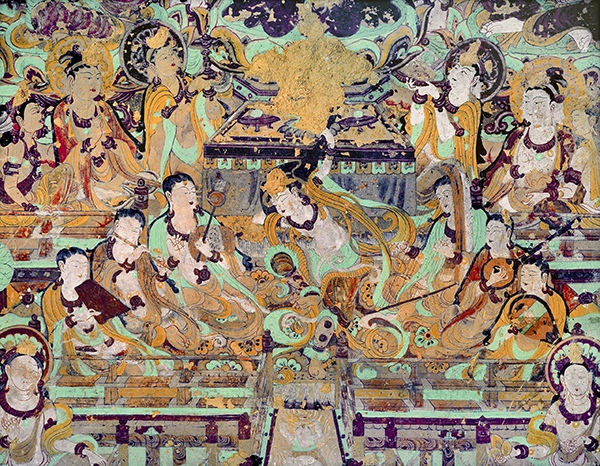
The grottoes we visited basically depict stories from the Buddhist scriptures or narrate the stories of Sakyamuni’s reincarnation before he became a Buddha.
One of the most worthy of mentioning is Cave 323, which was built during the early Tang Dynasty more than 1300 years ago. It contains a picture of Zhang Qian’s westward journey.
In the other caves, there are Buddha statues with colored glaze eyeballs (rebuilt in the Qing Dynasty), the four great heavenly kings (Sui Dynasty) that had not yet been Sinicized, and the Flying Apsaras depicted in different dynasties.
Mogao Grottoes is famous for its Flying Apsaras and Rebound Pipa. As for why Mogao Grottoes are so brilliant, it is because at that time Mogao Grottoes were mostly used for self-cultivation by prominent families as their own Buddhist caves. When it came to boasting of one’s own wealth, being stingy wouldn’t do, so the caves became rich cultural treasures. The great Buddha built by Cave 96 for Empress Wu Zetian can be reminiscent of the grand occasion.
I would like to pay special tribute to the people who worked in Mogao Grottoes during that special period of the year. At that time, they agreed that any grievances were placed outside the cave and cannot be brought into the cave. Otherwise, you did not have to wait for the natural weathering, and one fight would make all these clay sculptures become dust and disappear into the wind.
Perhaps one day, Mogao Grottoes will return to dust and dirt, but just because your name is Mogao Grottoes, as long as someone is there, someone will remember that you were once the most brilliant treasure in the desert.
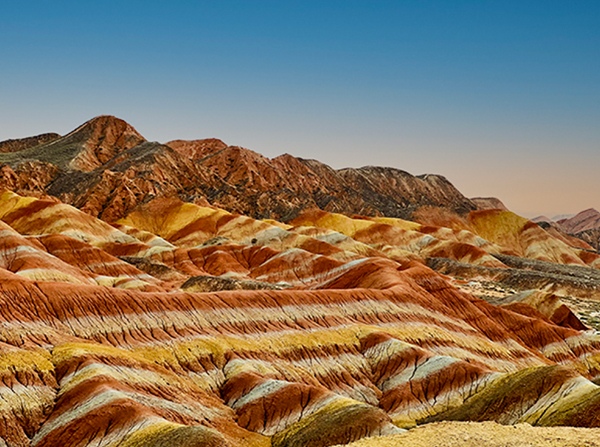
After we had a short rest, and we went to the penultimate stop — Zhangye Danxia — waiting for the sunrise while still half asleep and half awake.
I thought I wouldn’t be impressed after seeing the Danxia landforms of the Wave Valley in Xinjiang and Shaanxi, but I was once again amazed that it was like an oil painting brushed from God’s palette.
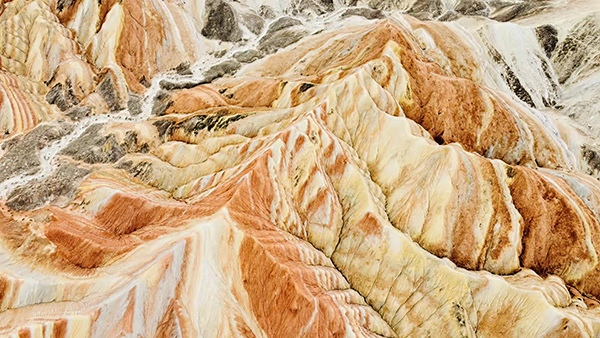
The Danxia landform can be viewed from a distance and cannot be traversed on foot. The reason is that even if it is something as ephemeral as a footprint, it will take hundreds or even thousands of years before it can be restored to its original state.
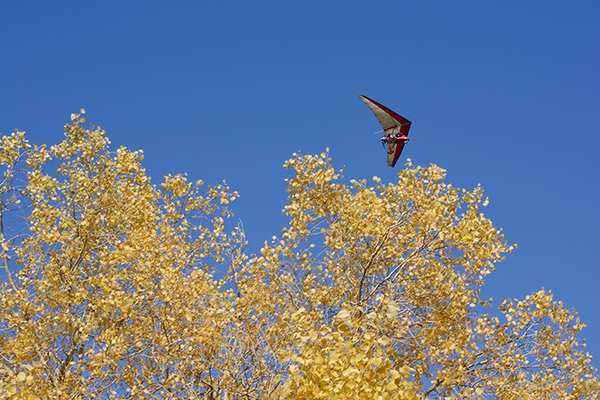
As if we had just set off yesterday, we had arrived at the last stop of the itinerary, Ejina Populus euphratica.

Populus euphratica, which do not die in a thousand years and do not fall after its death for another one thousand years, become immortal after the third thousand years. Therefore, there will be a watch for three thousand years, just waiting for your arrival.
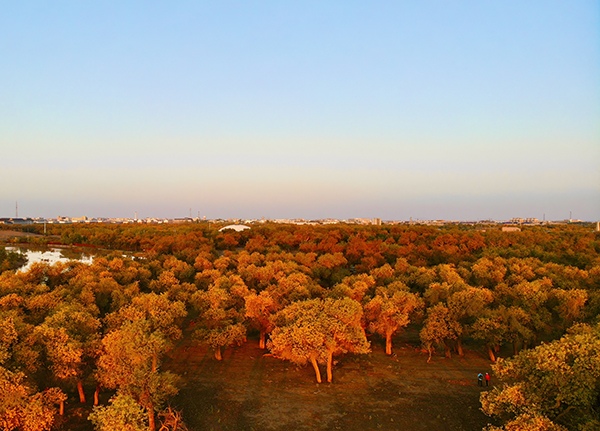
In fact, the entire trip to the Northwest can be summarized in this way. The thousand years’ watch is just for meeting you on the road.
Every place I walked through, like opening a history book, which is full of mottled vicissitudes, or glory, or loneliness, or brilliance, but in the past all kinds of things have fallen asleep under the river of time, whether you come or not, are all here. It’s good if you know it or don’t.
I have always firmly believed that everything that I encountered on the road was predetermined.
Whether it’s sunny, cloudy, rainy, snowy, foggy, sunny, or nighttime they all have their own appeal and the most suitable for you will be presented before your eyes.

The itinerary has ended and the holiday itself has come to an end. I met some new people, and some I didn’t. Where I want to go, there are always regrets and endless aftertaste. Everything has a cause and effect, and if you encounter it, it is the best arrangement. A grand journey is like this, as is life.